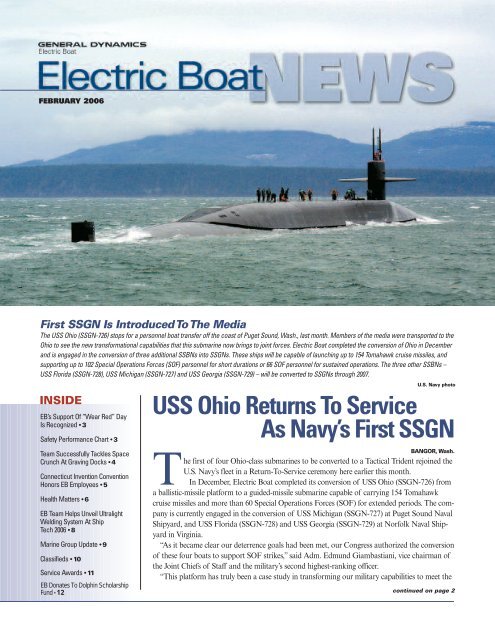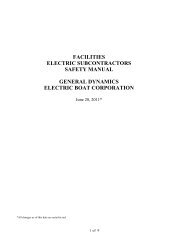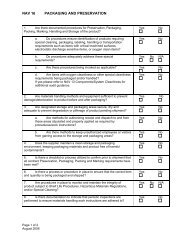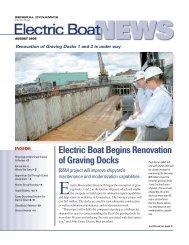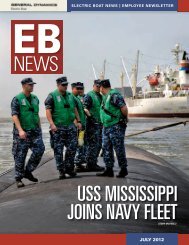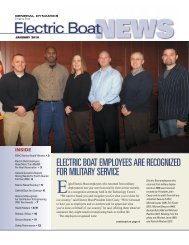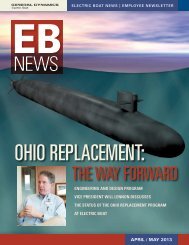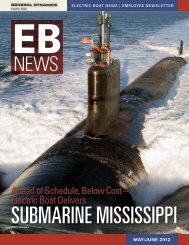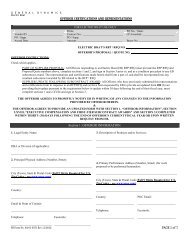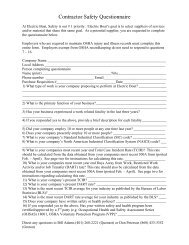EB news OCT 2002 bu - Electric Boat Corporation
EB news OCT 2002 bu - Electric Boat Corporation
EB news OCT 2002 bu - Electric Boat Corporation
You also want an ePaper? Increase the reach of your titles
YUMPU automatically turns print PDFs into web optimized ePapers that Google loves.
F<strong>EB</strong>RUARY 2006<br />
First SSGN Is Introduced To The Media<br />
The USS Ohio (SSGN-726) stops for a personnel boat transfer off the coast of Puget Sound, Wash., last month. Members of the media were transported to the<br />
Ohio to see the new transformational capabilities that this submarine now brings to joint forces. <strong>Electric</strong> <strong>Boat</strong> completed the conversion of Ohio in December<br />
and is engaged in the conversion of three additional SSBNs into SSGNs. These ships will be capable of launching up to 154 Tomahawk cruise missiles, and<br />
supporting up to 102 Special Operations Forces (SOF) personnel for short durations or 66 SOF personnel for sustained operations. The three other SSBNs –<br />
USS Florida (SSGN-728), USS Michigan (SSGN-727) and USS Georgia (SSGN-729) – will be converted to SSGNs through 2007.<br />
INSIDE<br />
<strong>EB</strong>’s Support Of “Wear Red” Day<br />
Is Recognized • 3<br />
Safety Performance Chart • 3<br />
Team Successfully Tackles Space<br />
Crunch At Graving Docks • 4<br />
Connecticut Invention Convention<br />
Honors <strong>EB</strong> Employees • 5<br />
Health Matters • 6<br />
<strong>EB</strong> Team Helps Unveil Ultralight<br />
Welding System At Ship<br />
Tech 2006 • 8<br />
Marine Group Update • 9<br />
Classifieds • 10<br />
Service Awards • 11<br />
<strong>EB</strong> Donates To Dolphin Scholarship<br />
Fund • 12<br />
U.S. Navy photo<br />
USS Ohio Returns To Service<br />
As Navy’s First SSGN<br />
BANGOR, Wash.<br />
The first of four Ohio-class submarines to be converted to a Tactical Trident rejoined the<br />
U.S. Navy’s fleet in a Return-To-Service ceremony here earlier this month.<br />
In December, <strong>Electric</strong> <strong>Boat</strong> completed its conversion of USS Ohio (SSGN-726) from<br />
a ballistic-missile platform to a guided-missile submarine capable of carrying 154 Tomahawk<br />
cruise missiles and more than 60 Special Operations Forces (SOF) for extended periods. The company<br />
is currently engaged in the conversion of USS Michigan (SSGN-727) at Puget Sound Naval<br />
Shipyard, and USS Florida (SSGN-728) and USS Georgia (SSGN-729) at Norfolk Naval Shipyard<br />
in Virginia.<br />
“As it became clear our deterrence goals had been met, our Congress authorized the conversion<br />
of these four boats to support SOF strikes,” said Adm. Edmund Giambastiani, vice chairman of<br />
the Joint Chiefs of Staff and the military’s second highest-ranking officer.<br />
“This platform has truly been a case study in transforming our military capabilities to meet the<br />
continued on page 2
Recording The SSGN Story<br />
Brian Kobylarz, who produces many <strong>Electric</strong> <strong>Boat</strong> films, videotapes Navy Capt. Dave DiOrio, left, director of the SSGN program office, as he describes the<br />
battle management center aboard USS Ohio (SSGN-726) and how it will provide true joint military integration. Ohio is the first SSGN converted from an<br />
SSBN and will provide transformational capabilities to joint war fighters.<br />
U.S. Navy photo<br />
continued from page 1<br />
future needs of our joint forces,” he continued.<br />
“In doing so, the Ohio has<br />
proven our concepts are validated as the<br />
SSGN prepares for an uncertain future<br />
by being on station and providing a forward-deployed<br />
presence, adaptability and<br />
modularity that are exactly the kind of<br />
capabilities the Quadrennial Defense<br />
Review calls for,” he said.<br />
Also speaking at the ceremony was<br />
<strong>Electric</strong> <strong>Boat</strong> President John Casey, who<br />
called the SSGN a powerful example of<br />
military transformation, with capabilities<br />
unmatched by any other ship on the<br />
planet.<br />
“SSGN represents more than just<br />
<strong>Electric</strong> <strong>Boat</strong>’s capability to construct<br />
one of the most sophisticated machines<br />
<strong>Electric</strong> <strong>Boat</strong>’s performance on the<br />
SSGN conversion program demonstrates<br />
clearly that the company and<br />
its workforce are national assets<br />
that must be sustained for our country’s<br />
security.<br />
on earth. Answering the Navy’s call, we<br />
progressed from a PowerPoint slide to<br />
finished product in just 39 months, transforming<br />
what was the consummate Cold<br />
War weapon to a platform uniquely configured<br />
for warfare in the 21st century.<br />
“Even though Ohio’s conversion to an<br />
SSGN configuration was a first-of-akind<br />
project, we overcame the unexpected<br />
and remained within both schedule<br />
and <strong>bu</strong>dget. In doing this, we displayed<br />
our ability to develop a concept,<br />
complete the detailed design, and perform<br />
the required manufacturing and<br />
construction work. Now, we’re prepared<br />
to support SSGN Ohio throughout its<br />
working life,” said Casey.<br />
“<strong>Electric</strong> <strong>Boat</strong>’s performance on the<br />
SSGN conversion program demonstrates<br />
clearly that the company and its workforce<br />
are national assets that must be sustained<br />
for our country’s security. Our<br />
goal is to support the Navy as it continues<br />
the transformation required to maintain<br />
maritime superiority in the 21st century,”<br />
he said.<br />
2 I February 2006 I ELECTRIC BOAT NEWS
January<br />
Safety<br />
Performance<br />
<strong>Electric</strong> <strong>Boat</strong>’s safety<br />
performance goal for 2006<br />
is to improve injury rates by<br />
at least 5 percent. The<br />
above chart shows that the<br />
company’s 2006 goal for<br />
Lost Workday Injury Rate<br />
(LWIR) is 2.6. At 2.6, the<br />
January LWIR met this<br />
goal. Note: LWIR = the<br />
number of lost workday<br />
injuries per 100 employees.<br />
Dan Barrett,<br />
Editor<br />
Dean R. Courtney,<br />
Contri<strong>bu</strong>ting Editor<br />
Bob Gallo,<br />
Gary Slater,<br />
Gary Hall,<br />
Photography<br />
<strong>EB</strong>’s Support Of “Wear Red” Day<br />
Is Recognized By American Heart<br />
Association<br />
On behalf of the American Heart Association, I would like to offer<br />
my thanks and congratulations to everyone at <strong>Electric</strong> <strong>Boat</strong> who<br />
supported this great cause by wearing red and making a donation.<br />
Through the years, the men and women of <strong>Electric</strong> <strong>Boat</strong> have shown time<br />
and again that they truly have HEART by raising money that funds lifesaving<br />
research and life-changing education. In addition, by wearing red on Feb. 3,<br />
you raised the awareness of everyone who saw you that day and hopefully<br />
thought about their own heart health. Moving people to recognize the risk<br />
factors for cardiovascular disease and stroke, to recognize the warning signs<br />
of heart attack and stroke, and to make changes that will help them lead<br />
more heart-healthy lives will save more lives than we will ever know.<br />
Thank you again. At <strong>Electric</strong> <strong>Boat</strong> you not only design and <strong>bu</strong>ild the best<br />
submarines in the world, <strong>bu</strong>t you also save lives every day! Keep up the great<br />
work!<br />
<strong>Electric</strong> <strong>Boat</strong> News is<br />
published monthly by the<br />
Public Affairs Department,<br />
75 Eastern Point Road,<br />
Groton, CT 06340<br />
Phone (860) 433-8202<br />
Fax (860) 433-8054<br />
Email<br />
dbarrett@ebmail.gdeb.com<br />
With deep appreciation,<br />
Tracy A. Brazelton<br />
Regional Vice President<br />
American Heart Association<br />
ELECTRIC BOAT NEWS I February 2006 I 3
Team Successfully<br />
Tackles Space Crunch<br />
At Graving Docks<br />
Anyone who has worked in <strong>EB</strong>’s Groton shipyard<br />
would agree that storage space is a rare commodity,<br />
particularly in and around Graving Docks 1 and 2.<br />
To improve the situation, and to reduce the crane and safety<br />
issues that have been occurring as a result of the space crunch at<br />
the docks, a dedicated Process Improvement team was established<br />
late last year – and it quickly got down to work.<br />
“Our objectives were to improve the usage around the graving<br />
docks and establish material laydown areas; improve on best<br />
practices and lessons learned; and investigate some new technologies<br />
for material handling and storage,” said Lifting & Handling<br />
Superintendent Jack Callinan (230), who presented an<br />
update on the team’s progress last month. “We still have a couple<br />
things to do, <strong>bu</strong>t we have much better control now.”<br />
Callinan said the team owes a debt of gratitude to many individuals<br />
within the shipyard for the project’s quick success. “It<br />
took a lot of help from a lot of different people to get where we<br />
are today,” he said, adding the timing of the project couldn’t<br />
have been better.<br />
“When the Secretary of the Navy came in recently, we didn’t<br />
have to go clean up the docks,” Callinan said. “The docks were<br />
ready for him.”<br />
In addition to the cleanup, the project also included the relocation<br />
of a few areas, including a smoking area, some fencing<br />
and a small parking lot. The end result: Larger, more efficient<br />
material laydown areas that are within the reach of the graving<br />
dock cranes.<br />
“Before this project, material was being stored all along the<br />
dock walls,” explained Lean Six Sigma green belt Mark<br />
Homand (459), another member of the Process Improvement<br />
team. “The crane walkers had to walk around all the material,<br />
so they were having trouble keeping the crane rails clear. It<br />
would get messy really quick.<br />
“You had vehicles running up and down the docks, so it was<br />
a constant safety hazard also,” he said. “So we decided to find<br />
nearby areas where we could place material and equipment for<br />
easy access during a job, or easy removal afterward.”<br />
Homand said a follow-on stage of the project will be to reorganize<br />
the Hunter Property in the South Yard, which will be<br />
used for overflow storage for the docks.<br />
“We’re reorganizing that so that the large equipment and<br />
material used in the graving docks has a place to go before and<br />
after a job, and in an organized fashion so we can get to it readily,”<br />
he said.<br />
Director of Operations Mike Alu (200) praised the team for<br />
its work, and then he issued a challenge: to create a system that<br />
Facilities employees relocate a fence near Graving Docks 1 and 2 last<br />
month as part of a Process Improvement to make more efficient use of the<br />
storage areas near the docks. From front to back are Jeff McKibben, Daniel<br />
Sanchez and Mike Campbell (all of 501). Missing from the photo is Ralph<br />
Perry (501), who served as the working leader for the fence relocation.<br />
brings to the graving docks only what’s needed for a given day<br />
or week. “Otherwise, you’ll start finding that you’re not going to<br />
have a place to put it,” he said.<br />
Callinan quickly replied that the team hasn’t finished yet, and<br />
is looking to make additional enhancements like Alu described.<br />
“I keep my garage at home clean, and I want to keep the graving<br />
docks clean as well,” Callinan said.<br />
Besides Callinan and Homand, the Process Improvement<br />
team included Robert Miller (271), Mark Mills (230), John Azzinaro<br />
(545), Mark Makoid (252), Bruce Hart (508) and William<br />
Newton (615).<br />
4 I February 2006 I ELECTRIC BOAT NEWS
Connecticut Invention Convention Honors <strong>EB</strong> Employees<br />
As a volunteer judge for the<br />
Connecticut Invention Convention,<br />
Mark A. Zecco, a program<br />
manager in Department 411, said<br />
he’d like one of the two-door mailboxes<br />
that one grade-school student developed.<br />
“I live on a terrible corner, and standing<br />
out there trying to get my mail can be<br />
pretty dangerous, <strong>bu</strong>t with a mailbox like<br />
that I could get it without stepping out<br />
into the street,” Zecco said.<br />
But he was most impressed with the<br />
contrivance that another young boy came<br />
up with to help his grandfather, who had<br />
suffered a stroke. Using Bungee Cords<br />
and Velcro, the boy came up with a way<br />
to secure silverware, plates and cups so<br />
his grandfather could eat without dropping<br />
any utensils.<br />
“That student’s heart was definitely in<br />
the right place,” Zecco said. “He put his<br />
time into solving a problem for someone<br />
in his family, when he could have been<br />
playing games.”<br />
The CIC recently hosted a lunch at<br />
<strong>Electric</strong> <strong>Boat</strong> to honor 24 <strong>EB</strong> employees<br />
who have given up one or more Saturdays<br />
to judge inventions during the competition,<br />
open to students in kindergarten<br />
to grade 8. Zecco is the most senior of<br />
them, having participated for the last<br />
eight years.<br />
<strong>EB</strong> President John P. Casey accepted a<br />
citation from the Connecticut General<br />
Assembly honoring the volunteers. Five<br />
state legislators attended the luncheon as<br />
well: Sens. Catherine Cook, R-Mystic,<br />
and Andrea Stillman, D-Waterford; and<br />
Reps. Betsy Ritter, D-Waterford, Kevin<br />
Ryan, D-Montville, and Diana Urban,<br />
R-North Stonington.<br />
“Innovation is a large part of what we<br />
do as a company, and this program is all<br />
about instilling that spirit of enthusiasm<br />
and inventiveness in the hearts of our<br />
children,” Casey said. “I’m really glad<br />
you all find the time to do this.”<br />
<strong>EB</strong> has turned out everything from the<br />
Navy’s first practical submarine, the Holland,<br />
to the first welded submarine, the<br />
first nuclear submarine, the first ballistic<br />
missile submarine, and now USS Virginia,<br />
the first warship designed for a<br />
post-Cold War environment, Casey said.<br />
“We’re hoping your participation in<br />
this program will impart that same sort<br />
of inventiveness to a new generation of<br />
young people,” he said.<br />
Marty Wood, Assistant Dean for<br />
Undergraduate Education at the University<br />
of Connecticut, said each year about<br />
650 students are chosen from a pool of<br />
about 10,000 <strong>bu</strong>dding inventors to<br />
advance to the final competition at the<br />
Harry A. Gampel Pavilion at UConn’s<br />
Storrs campus. The 23rd annual CIC will<br />
be April 29.<br />
Honora Kenney, secretary to the CIC<br />
board of directors, said one technique to<br />
encourage inventiveness is to give students<br />
small appliances to dismantle, to<br />
see the technology behind it.<br />
“The most recalcitrant child will try to<br />
take apart an iron, to figure out what<br />
makes it work,” Kenney said. “There’s a<br />
culture here of Yankee ingenuity.”<br />
She said the convention relies on 120<br />
volunteers each year to weigh the merits<br />
of students’ creations during the competition<br />
each year at Gampel. “Judges come<br />
away from this thinking this is a wonderful<br />
way to spend a Saturday morning.”<br />
The 24 judges from <strong>EB</strong> are the secondlargest<br />
company contingent in the state,<br />
second only to United Technologies<br />
Corp., which sends people from a halfdozen<br />
of its divisions in Connecticut, she<br />
said.<br />
“You’re part of the creation of a culture,<br />
a culture that will appreciate innovation,<br />
that will use it wisely,” Kenney<br />
said. “They’re going to become educated<br />
consumers and hopefully more informed<br />
citizens.”<br />
Anyone who would like to volunteer as<br />
a 2006 judge can get in touch with the<br />
organization by April 15 via the website,<br />
www.ctinventionconvention.org, or<br />
directly to Charlie.Baumgartner@ge.com.<br />
Apprentice Alumni Association<br />
Offers Three Scholarships<br />
The <strong>Electric</strong> <strong>Boat</strong> Apprentice Alumni Association (<strong>EB</strong>AAA) is offering scholarship awards of $2,000, $1,500<br />
and $1,000 for continuing education.<br />
The awards will be given to the children of <strong>EB</strong>AAA on the basis of academic achievement and desire to<br />
continue their education.<br />
Applications can be obtained from any member of the <strong>EB</strong>AAA board of directors, and must be submitted by April<br />
3. For more information, contact Mark Antrop (ext. 34640) or Andy Peacock (ext. 33024)<br />
ELECTRIC BOAT NEWS I February 2006 I 5
Bob Hurley, MD<br />
Medical Director<br />
HEALTH<br />
MATTERS<br />
AsI walked past one of<br />
the smoking kiosks<br />
the other day and<br />
noted the wide array of humanity happily<br />
puffing upon the latest offspring of<br />
Philip Morris, I was tempted to stop and<br />
offer them both good cheer and perhaps<br />
some useful advice. It pains me to admit<br />
that I did not. Perhaps it was the cold or<br />
some other issue on my mind, <strong>bu</strong>t I didn’t<br />
stop. On the other hand, some might<br />
argue the last thing people standing in<br />
19-degree weather need is a gray-haired<br />
physician lecturing them on the evils of<br />
smoking. Yet, the sentiment that I<br />
should have offered them something<br />
remains. I wonder if they would smoke if<br />
they understood what is known of<br />
tobacco and how effective it is in producing<br />
cancer. It is to those smokers in<br />
all the kiosks at <strong>EB</strong> that I dedicate this<br />
month’s column.<br />
6 I February 2006 I ELECTRIC BOAT<br />
cinogenic compounds such as polynuclear<br />
aromatic hydrocarbons, the classical carcinogen<br />
benzo (a) pyrene, and the nicotine-derived<br />
tobacco-specific nitrosamine,<br />
4-(methylnitrosamino)-1-(3-pyridyl)-1-<br />
<strong>bu</strong>tanone interact with lung epithelium.<br />
Recent experimental evidence has confirmed<br />
that the carcinogens that come in<br />
contact with the cells of the epithelium<br />
cause damage to the cellular DNA. These<br />
cigarette carcinogens in smoke drive the<br />
multi-step process. The chemicals form<br />
what is known as a DNA adduct, which<br />
can interact with your lung tissue to initiate<br />
cancer.<br />
Let’s look at a simplified process of<br />
carcinogenesis. The tissue in your throat<br />
and lungs is epithelial tissue which, when<br />
exposed on a daily basis over years to the<br />
agents in cigarette smoke, initiates a series<br />
of steps. Under the right circumstances,<br />
lung epithelium will conceptually undergo<br />
three phases: initiation, promotion and<br />
progression. Initiation is thought of as an<br />
irreversible change of the DNA within a<br />
cell that arises from an interaction with a<br />
carcinogen that is necessary, <strong>bu</strong>t not sufficient,<br />
for tumor development. If your<br />
exposure were to cease at this point, the<br />
cell may or may not go on to become a<br />
cancer cell. The irreversible changes in<br />
DNA are called DNA adducts, which set<br />
up individuals for the next potential<br />
occurrence in this multi-step process. Promotion<br />
is the subsequent process that<br />
facilitates tumor development. Unlike initiation,<br />
which binds to DNA and alters it,<br />
promotion suppresses proteins within the<br />
cell and alters the expression and transcription<br />
of DNA. Promotion often<br />
changes things like membrane receptors<br />
that impact cellular growth and differentiation.<br />
Promotion typically causes a preneoplastic<br />
cell that lacks the ability to<br />
invade other tissue or metastasize to other<br />
parts of the body. The last step, progression,<br />
makes possible the genetic changes<br />
that turn this cell into a true malignant<br />
cell. This cell has many abilities such as<br />
sustained cell growth and metastasis.<br />
Carcinogenesis is not this simple, and<br />
agents such as cigarette smoke possess<br />
It is well recognized that tobacco exposure<br />
is the dominant risk factor for lung<br />
cancer. Cigarette smoking and secondhand<br />
smoke have been definitively established<br />
by epidemiologic and preclinical<br />
animal experimental data as the primary<br />
cause of lung cancer. The percentages of<br />
lung cancers estimated to be caused by<br />
tobacco smoking in males and females<br />
are 90 percent and 78 percent, respectively.<br />
We know that lung cancers have<br />
increased in both men and women over<br />
the past few decades. Despite improved<br />
detection and treatment, this growing<br />
incidence has increased the <strong>bu</strong>rden on<br />
society when viewed from a population<br />
perspective. The epidemiological viewpoint<br />
is clear that smoking significantly<br />
harms a population both in cost of evaluation<br />
and treatment as well as lost productivity<br />
and life. When compared to<br />
non-smokers, the smoking population<br />
has a dose-dependent increase in the risk<br />
of dying from lung, head and neck, bladder<br />
and other cancers. In short, the more<br />
you smoke, the more risk you have of<br />
getting cancer. On the other hand, if you<br />
stop smoking you reduce your risk of<br />
cancer. It sounds pretty straightforward,<br />
<strong>bu</strong>t why is it so?<br />
It has a lot to do with presentation of<br />
exposure. The more times you expose<br />
your body to carcinogens, the more<br />
chance you have of getting cancer. Have<br />
you ever wondered what happens to a<br />
cell within your body that decides to<br />
become cancerous? Scientists have<br />
learned some of the “rules,”and<br />
although these rules are not hard and<br />
fast and are subject to change, we do<br />
have a rudimentary understanding of<br />
what it takes to change one of your cells<br />
into a cancer cell.<br />
One of the reasons that tobacco in<br />
smoke form is so effective is that you<br />
present the carcinogenic substance deep<br />
within your body in vulnerable regions.<br />
Once placed onto your lung epithelium,<br />
multiple actions take place at the cellular<br />
level. In the multi-step carcinogenesis<br />
process, cigarette smoke, laden with carcontinued<br />
on page 7
Colors Make Healthy Eating Easier<br />
Have you noticed the new labels in the Groton and Quonset Point cafeterias? These color-coordinated labels are designed to<br />
help you make informed choices about healthy food options.<br />
Foods are characterized by the colors green, yellow and red – the same as a traffic light:<br />
Green-light (Go) foods – Eat these foods frequently. They include fresh fruits, non-starchy vegetables, salads with small amounts of<br />
low-fat dressings, and fat-free dairy products. Eat baked, broiled or canned skinless chicken, turkey and fish. Fruits and vegetables are<br />
good for snacks because they are easy to carry around.<br />
Yellow-light (Slow) foods – Portion size matters with these foods. Don’t have more than five or six small servings each day of<br />
starchy vegetables (potatoes, corn and peas), pasta or bread.<br />
Red-light (Whoa) foods – Any food with high fat, sugar or calories belongs on the red-light list. Limit your consumption of` the following:<br />
cakes, cookies, pies, fatty meats, fast food, fruit juices and pizza. Soda, bottled lemonade and iced tea also are on this list.<br />
Health-care advocate Sonia Garcia can give information on healthy eating and other topics. For an appointment at her Yard Hospital<br />
office, call 1-800-848-4747, ext 8318.<br />
continued from page 6<br />
both initiator and promoter qualities,<br />
making them “complete carcinogens.” If<br />
this wasn’t bad enough, cigarette smoke<br />
sets the stage for other carcinogens that<br />
may be present in the lung. Inhaled<br />
cigarette smoke alone has well over 1,000<br />
compounds.<br />
As I said earlier, this rudimentary construct<br />
of multi-step progression is constantly<br />
being revised as we acquire more<br />
knowledge. Current research suggests the<br />
multi-step process is increasingly complex<br />
and the evidence blurs the distinction<br />
between initiation, promotion and progression.<br />
In addition, latency, the time<br />
between exposure and initiation may be<br />
great. Cancers associated with exposure<br />
are now known to take from 10 to 20<br />
years to develop, making identification of<br />
the causative agent indeed difficult.<br />
We have learned that when the DNA<br />
within cells is altered, this leads to tumor<br />
development, which is at least partly due<br />
to mutations of proto-oncogene and<br />
tumor suppressor genes. A proto-oncogene<br />
contains the altered DNA sequences<br />
we talked about with initiation. When<br />
stimulated by a “complete carcinogen”<br />
such as cigarette smoke, this potential<br />
alteration becomes an oncogene, which in<br />
turn stimulates the cell to transform and<br />
proliferate as a potentially neoplastic cell.<br />
These genes we have labeled proto-oncogene<br />
are necessary for normal cell maturation<br />
and differentiation. Those labeled<br />
tumor-suppressor genes typically act to<br />
regulate cell growth. With inactivation of<br />
one of these genes, the cell grows in an<br />
unregulated manner.<br />
And if the above were not enough,<br />
please consider the following. We have<br />
looked at cancer from the perspective of a<br />
single cell. What of a group or area of<br />
cells? From the perspective of “field carcinogenesis,”<br />
we know that individuals<br />
exposed to carcinogenic tobacco smoke<br />
develop multiple areas of independent<br />
neoplastic lesions. We also know that<br />
patients developing cancers of the lungs<br />
and throat secondary to cigarette smoke<br />
also are likely to have multiple premalignant<br />
lesions of independent origin within<br />
the carcinogen-exposed field.<br />
If the first wave doesn’t get you, the<br />
second wave will.<br />
Back at the Kiosk<br />
At this point, I think we’re all in agreement<br />
that this information is better presented<br />
in “Health Matters,” rather than a<br />
cold kiosk. I hope it gets someone thinking<br />
about quitting. If you are to believe<br />
experts, they tell me that 58 percent of all<br />
smokers want to quit. If you’re one of<br />
them, then please feel free to see me or<br />
one of the providers at the Yard Hospital<br />
to discuss your desire to quit. We can help<br />
you formulate a plan of action. If you<br />
prefer to cease off-campus or have other<br />
questions, please call Sonia Garcia at<br />
1-800-848-4747, ext. 8318. She can help<br />
you navigate the multiple resources of<br />
smoking cessation.<br />
ELECTRIC BOAT NEWS I February 2006 I 7
Ultralight<br />
Welding Team<br />
Displays<br />
Product<br />
Mockup<br />
Members of the <strong>EB</strong> team<br />
that helped develop a new<br />
welding system for the ship<strong>bu</strong>ilding<br />
industry stand<br />
behind a mockup display at<br />
the recent Ship Tech 2006<br />
event in Panama City, Fla.<br />
From left are Doc Holliday<br />
(229), Andrew Stockton (405)<br />
and Scott Wardwell (229). At<br />
right is Kevin Carpenter, representing<br />
the Advanced<br />
Technology Institute/Center<br />
for Naval Ship<strong>bu</strong>ilding Technology.<br />
<strong>EB</strong> Team Helps Unveil Ultralight<br />
Welding System At Ship Tech 2006<br />
PANAMA CITY, Fla.<br />
The development of an ultralight<br />
gas metal arc welding system<br />
for ship<strong>bu</strong>ilders marked a key<br />
milestone when the system was unveiled<br />
at a recent industry meeting here.<br />
This new welding system is being<br />
developed by a government/industry<br />
team comprising the Advanced Technology<br />
Institute/Center for Naval Ship<strong>bu</strong>ilding<br />
Technology (ATI/CNST) – the government<br />
sponsor; the Lincoln <strong>Electric</strong><br />
Company – the co-sponsor responsible<br />
for product development; and <strong>EB</strong> –<br />
which is defining welding-system requirements<br />
and evaluating the system throughout<br />
its development. <strong>EB</strong>’s Ultralight team<br />
members are Doc Holliday (229), Scott<br />
Wardwell (229) and Andrew Stockton<br />
(405).<br />
<strong>EB</strong> has been a major proponent of the<br />
development of Ultralight. Beginning in<br />
November 2003, the company led a proposal<br />
development effort that resulted in<br />
$1.7 million of funding for Ultralight<br />
from CNST and Lincoln <strong>Electric</strong>. The<br />
prototype Ultralight welding system is<br />
now under evaluation at the <strong>EB</strong> Welding<br />
Engineering Laboratory. This evaluation<br />
is scheduled for completion in September.<br />
At 45 pounds, the Ultralight welding<br />
system will perform many of the welding<br />
operations currently done in the shipyard<br />
with 175 pounds of equipment, thus<br />
eliminating many handling requirements.<br />
In addition to being portable, Ultralight<br />
will provide a greater degree of shipyard<br />
safety because it operates on 220-volt single-phase<br />
power rather than the 440-volt<br />
three-phase power required by welding<br />
systems now in use.<br />
Holliday, the Ultralight project lead for<br />
Operations, has high hopes for the new<br />
welding system. “Progress made by Lincoln<br />
<strong>Electric</strong> has exceeded our expectations,”<br />
he said. “Lincoln has worked<br />
closely with <strong>EB</strong> in implementing our<br />
requirements and supporting testing in<br />
the <strong>EB</strong> Welding Engineering Laboratory.<br />
Given Lincoln’s performance so far, I feel<br />
confident that Ultralight will meet or<br />
exceed the demanding requirements of<br />
the shipyard.”<br />
To further ensure the acceptance of<br />
Ultralight by the shipyard, the <strong>EB</strong> Ultralight<br />
team is also collaborating with<br />
Lenco, a producer of welding supplies,<br />
on the development of a light agile torch<br />
to use with the new welding system. This<br />
evaluation of a new torch design is being<br />
led by Wardwell, who praised Lenco’s<br />
support. “Lenco has offered to modify<br />
one of their production torches to meet<br />
our requirements. We expect that this new<br />
lightweight flexible head torch will be an<br />
excellent match for the Ultralight welding<br />
system.”<br />
8 I February 2006 I ELECTRIC BOAT NEWS
<strong>EB</strong> Receives<br />
$1.35 Billion<br />
Contract<br />
Modification<br />
For Virginia-Class<br />
Submarine<br />
Procurement<br />
The U.S. Navy has awarded<br />
<strong>Electric</strong> <strong>Boat</strong> a $1.35 billion<br />
contract modification that provides<br />
funding for the construction of the<br />
eighth Virginia-class submarine and<br />
advance procurement for the ninth and<br />
10th ships of the class.<br />
The award modifies an August 2003<br />
contract for the construction of six Virginia-class<br />
submarines at a rate of one<br />
per year from FY 03 through FY 08; the<br />
total value of the contract is $8.4 billion.<br />
Altogether, <strong>Electric</strong> <strong>Boat</strong> and its construction<br />
teammate, Northrop Grumman,<br />
have received contracts to <strong>bu</strong>ild 10<br />
ships of the class. The lead ship, USS<br />
Virginia (SSN-774), was delivered to the<br />
Navy in October 2004.<br />
This contract modification has been<br />
factored into the company’s workload<br />
projections since the initial contract was<br />
announced in 2003. It is not unplanned<br />
work. For that reason, it will not affect<br />
the number of layoffs the company will<br />
make over the next two years<br />
The contract modification provides<br />
$1.1 billion for construction of SSN-781,<br />
$208 million in advance procurement for<br />
SSN-782 and $40 million for SSN-783.<br />
Fifteen percent of the work will be<br />
performed at <strong>Electric</strong> <strong>Boat</strong>’s Groton<br />
shipyard; 15 percent at its Quonset<br />
Point, R.I., facility; 30 percent at<br />
Northrop Grumman in Newport News,<br />
Va.; and 40 percent at various sites<br />
throughout the U.S. Work under the<br />
overall contract is scheduled for completion<br />
in 2014 when SSN-783 is delivered.<br />
Marine Group Update<br />
<strong>Electric</strong> <strong>Boat</strong> Is Awarded $9 Million<br />
For Submarine Support Work<br />
<strong>Electric</strong> <strong>Boat</strong> has received a $9 million modification to an existing contract for<br />
submarine modernization and related work at the Naval Submarine Base in<br />
Groton.<br />
Initially awarded in October 2001, the overall contract could be worth $142 million<br />
over five years if all options are exercised and funded.<br />
Under the terms of the modification, <strong>Electric</strong> <strong>Boat</strong> will continue to perform nonnuclear<br />
submarine modernization and repair services at the Naval Submarine Support<br />
Facility at the Base. These services include intermediate overhaul, repair and modernization<br />
activities in support of submarines and the Shippingport floating drydock, as<br />
well as support and service craft.<br />
NASSCO Lands $317M Contract To Build<br />
Ninth T-AKE Dry Cargo / Ammunition Ship<br />
SAN DIEGO, Calif.<br />
General Dynamics NASSCO has received a contract option from the U.S.<br />
Navy to <strong>bu</strong>ild an additional ship under the T-AKE program, a new class of<br />
combat logistics force ships. The $317 million contract brings the total number<br />
of T-AKE ships awarded to NASSCO to nine, and the total contract value to $2.8<br />
billion. Options for three additional T-AKE ships remain available under the existing<br />
contract.<br />
Exercise of this option brings NASSCO’s backlog to 10 ships, including the nine<br />
T-AKEs and the fourth of four double-hull oil tankers being <strong>bu</strong>ilt for BP Shipping<br />
Company of Alaska.<br />
The first T-AKE, the USNS Lewis and Clark, was launched in May 2005 and delivery<br />
is scheduled for the second quarter of this year. The second T-AKE, to be named<br />
the USNS Sacagawea, is now in full-rate production and will be launched May 23.<br />
Construction on the third T-AKE, to be named the USNS Alan Shepard in honor of<br />
the first American in space, began last September.<br />
The T-AKE is a dry cargo/ammunition ship that will be operated by the Military<br />
Sealift Command, providing logistic support from sources of supply either in port or<br />
at sea. The ships will transfer cargo – ammunition, food, fuel, repair parts, and expendable<br />
supplies and material – to naval forces at sea.<br />
The T-AKEs are 689 feet in length and 105.6 feet in beam, with a design draft of<br />
29.9 feet. The ships can carry almost 7,000 metric tons of dry cargo and ammunition<br />
and 23,500 barrels of marine diesel fuel. The T-AKEs are the first modern Navy ships<br />
to combine proven international marine technologies such as an integrated electricdrive<br />
propulsion system with commercial design features that will minimize their cost<br />
of operation and maintenance over their expected 40-year life.<br />
ELECTRIC BOAT NEWS I February 2006 I 9
Classified<br />
AUTOS/TRUCKS<br />
DODGE DAKOTA SPORT 1999.<br />
105k miles, 5-spd., 4WD, 5.2L, V-8,<br />
with tow hitch/harness, locking<br />
fiberglass tonneau, all amenities,<br />
new tires. Asking $9,500. 460-2086.<br />
GRAND PRIX 2000. V-6, 3.1, 4-dr,<br />
$3,500. 822-9614.<br />
BOATS<br />
MARINE VOLVO. GM 350/5.7 duo<br />
prop. New parts – risers, zincs,<br />
water pump, starter, alternator,<br />
anchors, lines, two pedestal seats<br />
with cushions, <strong>bu</strong>mpers, life jackets,<br />
fishing tackle. 572-0655.<br />
SEA-DOO JET SKI 2003. 3-seater,<br />
85HP, used in fresh water only, 20<br />
hours of use, includes trailer and<br />
cover, excellent condition. $4,800<br />
OBO. 401-206-9225, leave message.<br />
FURNITURE<br />
$<br />
CONTEMPORARY OAK entertainment<br />
center. Six electronic component<br />
shelves, including 27”-30” TV.<br />
Tinted glass doors, media/book<br />
storage and two drawers. Dimensions:<br />
54-1/4Hx56Wx20D. $450<br />
OBO. 535-3231.<br />
DOUBLE BED with new mattress &<br />
dresser with mirror. Good condition.<br />
$100. You pick up. 401-348-<br />
6769.<br />
QUEEN-SIZE mattress, box spring<br />
and headboard. Good condition.<br />
$70 OBO. 535-4647.<br />
WICKER chaise lounge. Natural<br />
wicker with princess back. Removable<br />
dark-green cushions. $150<br />
OBO. 401-885-5811.<br />
MISCELLANEOUS<br />
AMERICAN GIRL DOLL CLOTHES<br />
& furniture. 1959 Ken doll, wooden<br />
doll’s cradle, new ballerina porcelain<br />
doll, Crissy doll, Elvis Presley<br />
doll, Mickey Mouse earrings, children’s<br />
books. 401-596-5788.<br />
HAVILAND CHINA. 4 place settings,<br />
28 pieces. Collectible Fostoria<br />
glassware, Wolfschmidt Vodka<br />
framed mirror, Star Wars collectibles,<br />
5-section ceramic Lazy<br />
Susan, demitasse cups & saucers,<br />
new infant’s blanket. 401-596-5788.<br />
HORS<strong>EB</strong>ACK RIDING PANTS. On<br />
Course cotton naturals<br />
(cotton/lycra), padded full seat and<br />
inner thigh, size 38. Colors: tan,<br />
black and gray. $15 each. 884-6105,<br />
leave message.<br />
REAL ESTATE /<br />
RENTALS<br />
APT FOR RENT. West Warwick,<br />
2br/1ba. Great location close to<br />
Quonset. Heat, hot water, cable TV,<br />
2-car parking included. $895 per<br />
To submit a classified ad, send an e-mail<br />
to <strong>EB</strong>NewsAds@gdeb.com with the following information:<br />
CATEGORY choose from<br />
Appliances<br />
Autos / Trucks<br />
Auto Parts<br />
<strong>Boat</strong>s<br />
Computers<br />
Furniture<br />
Miscellaneous<br />
Motorcycles<br />
ITEM NAME; DESCRIPTION; ASKING PRICE; and<br />
HOME TELEPHONE (include area code if outside 860).<br />
Deadline is the 15th of the month.<br />
Maximum of two 25-word ads per employee per issue.<br />
Please include your name, department and work<br />
extension with your ad (not for publication).<br />
Employees without e-mail can submit their ads through<br />
interoffice mail to:<br />
month. First month and security<br />
required. 401-368-6420.<br />
CAPE COD RENTAL. Four bedroom,<br />
well-kept Cape in Falmouth,<br />
Mass. Great location for all local<br />
activities and launch pad to the rest<br />
of Cape. $1,000/wk. 572-0434.<br />
HOUSE FOR RENT. Half of duplex –<br />
Westerly. Quiet neighborhood. 3<br />
bedroom/2 baths, gas heat, offstreet<br />
parking with semi-private<br />
yard. Close to schools and I-95.<br />
Walking distance to gym. $1,000<br />
plus security. 401-741-3342.<br />
Pets<br />
Real Estate /<br />
Rentals<br />
Dan Barrett,<br />
<strong>EB</strong> Classified, Dept. 605,<br />
Station J88-10.<br />
NICE FIRST FLOOR APT. 1 br,<br />
newly carpeted, walk to L&M, offstreet<br />
parking, non-smoker, no<br />
pets. $700 + utilities. One month<br />
security. 442-4050 after 6 PM.<br />
REAL ESTATE /<br />
SALES<br />
Real Estate /<br />
Sales<br />
Wanted<br />
LAND LOTS. Cape Coral, Fla. One<br />
double lot, one across from water,<br />
one on water. 401-348-6769.<br />
Retirees<br />
100 Elie P. Lisee<br />
32 years<br />
ISM-Horizbor Mac 1/C<br />
252 John T. Reilly<br />
29 years<br />
Carpenter 1/C<br />
423 Harry V. Pontarelli Jr.<br />
44 years<br />
Manager of Quality<br />
795 Steven M. Mailhot<br />
32 years<br />
Foreman<br />
221 Nancy A. Gries<br />
26 years<br />
Supv., Ops Support<br />
330 Raymond E. Gill Jr.<br />
19 years<br />
Buyer Specialist<br />
449 Ronald L. Clark<br />
40 years<br />
Engineer Senior<br />
816 Richard L. Kemper<br />
2 years<br />
Supt. Asst.-Site<br />
226 Roger J. Beaudoin<br />
32 years<br />
Plate Shop Mech. 1/C<br />
355 Angelo J. Grillo<br />
34 years<br />
Prod. Planner<br />
459 Henry Plaskett<br />
10 years<br />
Design Tech.-Struct.<br />
904 Richard P. Dauphinais<br />
30 years<br />
Install. Mech. I<br />
242 Leo E. Niskanen<br />
30 years<br />
O/S Machinist 1/C<br />
421 Jean P. Leca<br />
42 years<br />
Engineer<br />
706 David J. Evans Jr.<br />
22 years<br />
Supv. of Planning<br />
935 Victor J. Heroux<br />
30 years<br />
Prod. Supp. Tech. I<br />
10 I February 2006 I ELECTRIC BOAT NEWS
Service Awards<br />
40 years ELECTRIC BOAT NEWS I February 2006 I 11<br />
462 George J. Schackner<br />
35 years<br />
226 William A. Danusis<br />
229 William A. Starz<br />
242 James R. Wilson<br />
330 George B. Zurcher<br />
404 Ronald E. Johanson<br />
445 Gary A. Kosegarten<br />
449 Robert H. Smith<br />
456 James F. Osborne<br />
458 Jeffrey A. Marchese<br />
650 Eugene A. Netze<br />
915 Michael E. Andreozzi<br />
30 years<br />
200 James W. Campbell<br />
221 Paul D. Campo<br />
221 Robert E. Dubois<br />
221 Cora E. Rogers<br />
226 Michael A. Civitello<br />
229 David T. Holliday<br />
241 Charles A. Witt Jr.<br />
242 James J. Chinigo<br />
243 Stephen B. Farrell<br />
244 Lucien E. Frechette<br />
246 Mark S. Carchidi<br />
248 Francis J. Bellanceau<br />
252 John E. Litchfield<br />
252 Paul W. Gluck<br />
252 Paul L. Laflamme<br />
271 Harold T. Calkins Jr.<br />
272 Frederick J. Honnen III<br />
275 Peter W. Dalton<br />
321 John J. Sigersmith<br />
322 Robert J. Ruffo<br />
323 Gary G. Fisette<br />
355 Franklin L. Frucce<br />
355 Theodore E. Powaleny<br />
355 Richard H. Vescovi<br />
355 Ernest A. Brown Jr.<br />
355 Jeffrey L. Emmerich<br />
355 Victoria M. Field<br />
403 David F. Vetelino<br />
413 Deborah A. Roy<br />
421 Ronald T. McGuire<br />
434 Paula M. Doiron<br />
447 Robert J. Plouffe<br />
447 Steven E. Lonergan<br />
452 John M. Pellegrino<br />
452 Gary D. DeWolf<br />
459 Lawrence R. Paolilli<br />
459 David J. Smith<br />
472 Cornelius P. Kane Sr.<br />
495 Roy G. Adamson<br />
495 Nicholas G. Ilasi<br />
501 Edward S. Hill<br />
501 Sharon L.Viadella<br />
505 Donald K. Kaschel<br />
601 John D. Holmander<br />
604 Guy Henry<br />
642 Nathaniel Axson<br />
706 Ralph T. Myers<br />
795 Larry P. Funk<br />
811 Daniel R. Sykora<br />
821 Frederick W. Aird Jr.<br />
901 Daniel P. Dias<br />
901 Charles E. Jendzejec<br />
901 Raymond E. Lewis Jr.<br />
901 Richard J. Losasso<br />
901 Michael J. Melia<br />
902 Richard A. Ferris<br />
902 Robert A. Henderson<br />
904 Robert W. Cote<br />
904 Paul J. Supinski<br />
904 Stephen P. Tenerella<br />
915 Mark T. Gaito<br />
915 James E. Glanvill<br />
915 Raymond A. Rohrig<br />
921 Paul D. Carpentier<br />
921 Gerard E. Laliberte<br />
921 James B. Reynolds<br />
924 Richard N. Doucette<br />
924 Richard D. Lineham<br />
924 Steven M. Uth<br />
950 Richard J. Catterall<br />
957 Vincent Salzillo<br />
970 Ronald S. Silva<br />
221 James J. Cherenzia<br />
226 Thomas L. Lamoureux<br />
227 Leon M. Gay<br />
229 Jaime Perez Rodrigu<br />
229 Marie M. Trapp<br />
251 Willie P. Fulse<br />
251 Richard J. Villemure<br />
251 Beverly J. Webb<br />
251 Danny R. Berymon<br />
251 Donna F. Blanco<br />
251 Herminio Cordero<br />
251 Arthur R. Guay<br />
251 Deborah A. Hoffman<br />
251 Catherine E. Race<br />
251 Jane F. Rose<br />
251 Heriberto Santiago<br />
251 Kenneth R. White<br />
251 Sarah I. Williams<br />
252 John H. Peabody<br />
252 Matthew J. Yuhas<br />
252 Alfred J. Alviani<br />
252 Roland J. Denomme<br />
252 Paul S. McDaniel<br />
252 Kevin F. Savage<br />
321 Walter G. Haas<br />
323 Robert R. Smelings<br />
330 Eric G. Dudda<br />
341 Ben J. Edwards Jr.<br />
341 John J. Gullotti<br />
355 Eileen J. Gibson<br />
405 Michael A. Drurey<br />
412 John E. Marriott IV<br />
412 Jonathan P. Morin<br />
424 Frederick N. Harvey<br />
425 William C. Henderson Jr.<br />
428 John S. Stockford<br />
431 Joseph M. Carilli<br />
434 Scott A. Riding<br />
436 Rita A. Sommers<br />
438 Thomas P. Broughton<br />
441 Nadia S. Meseha<br />
445 Gregory J. Congdon<br />
447 Roni M. Oddo<br />
452 Diane M. Tatro<br />
452 Kevin W. Tierney<br />
456 Thomas J. Beams<br />
456 Kenneth P. Ferria<br />
456 Ronald W. Goodrich<br />
456 Thomas L. Theroux<br />
458 Gary A. Slater<br />
459 Deborah A. Bonelli<br />
459 William G. Dambach<br />
459 Thomas C. Hodgkins<br />
459 Richard S. Jenks<br />
459 Katrina C. Magee<br />
459 Kevin Mooney<br />
459 Kevin J. Slocum<br />
494 Edmund L. Czapek Jr.<br />
502 Peter P. Blazejak<br />
505 Michael P. Reynolds<br />
505 Edward E. Costa<br />
505 Sandy J. Gray<br />
505 Dennis A. Rolfe<br />
650 Paul A. Magwood<br />
702 Terence J. Ferrara<br />
706 John W. Hurlock<br />
901 Albert G. Barish Jr.<br />
901 Eric S. Lofgren<br />
904 John A. Medeiros<br />
25 years 460 James L. Babcock<br />
493 Alexandros Pettas<br />
495 Jody L. Lees<br />
915 Neil J. Mulcahy<br />
915 James A. Paolino<br />
915 Joseph J. Santos<br />
915 Robert G. St. Pierre<br />
915 Michael R. Thornton<br />
924 Michael J. O’Donnell<br />
951 Lee Westall<br />
957 John N. Pucci<br />
20 years<br />
100 Albert J. Boudreau<br />
229 Daniel F. Hill<br />
241 David D. Vanner<br />
242 Charles A. Klaben<br />
243 John W. Hollis III<br />
252 Scott T. Colan<br />
321 Patrick R. Daignault<br />
341 Mary L. Connolly<br />
341 James A. Newman<br />
403 David A. Jakob<br />
403 Michael H. Johnston<br />
404 Mary E. Harrison<br />
405 Donald C. McLeod<br />
411 Eileen B. Herrington<br />
425 Robert A. Buono<br />
425 Christine M. Kutneski<br />
433 Marian S. Harris<br />
433 Albert N. Miller<br />
434 Stephen B. Moretti<br />
436 Pamela J. Mercado<br />
437 Samuel K. Houpt<br />
447 Lynn B. Kanyock<br />
456 Ralph F. Boles<br />
915 Samuel E. Robinson Jr.<br />
951 Frederick D. Weller Jr.<br />
251 Celso Melechias Frade Jr.<br />
403 Christopher B. Atwood<br />
456 Jeffrey M. Grandchamp<br />
459 Glenwood S. Curtis Jr.<br />
501 Michael W. Grant<br />
545 Paul G. Rosa<br />
614 Elizabeth J. Perry<br />
626 David W. Ayers<br />
650 Kevin L. Leyland<br />
670 Scott A. Flynn<br />
705 Donald R. Jacobs Jr.<br />
742 James W. Laswell<br />
811 John P. Carney<br />
902 Paul M. Cournoyer<br />
915 David A. Demilia<br />
915 Victor V. Folco
STANDARD PRESORT<br />
U.S. POSTAGE<br />
PAID<br />
GROTON, CT<br />
PERMIT NO. 392<br />
<strong>EB</strong> donates<br />
$10,000<br />
To Dolphin<br />
Scholarship<br />
Fund<br />
<strong>Electric</strong> <strong>Boat</strong> has donated<br />
$10,000 to the Dolphin Scholarship<br />
Foundation, an organization<br />
that supports children of current<br />
and former submariners. <strong>EB</strong><br />
President John Casey presented<br />
the check to Mrs. Kristin<br />
Munns, president of the scholarship<br />
foundation and the wife<br />
of Vice Adm. Charles L. Munns,<br />
Commander – Naval Submarine<br />
Forces. Since it was established<br />
in 1961, the foundation has<br />
awarded more than $5.8 million<br />
in scholarships to nearly 900<br />
students pursuing their undergraduate<br />
college degrees.


